6 Best Vet-Approved Dog Thermometers of 2025
Reviewed by Sarah J. Wooten, DVM. Updated on July 08, 2024
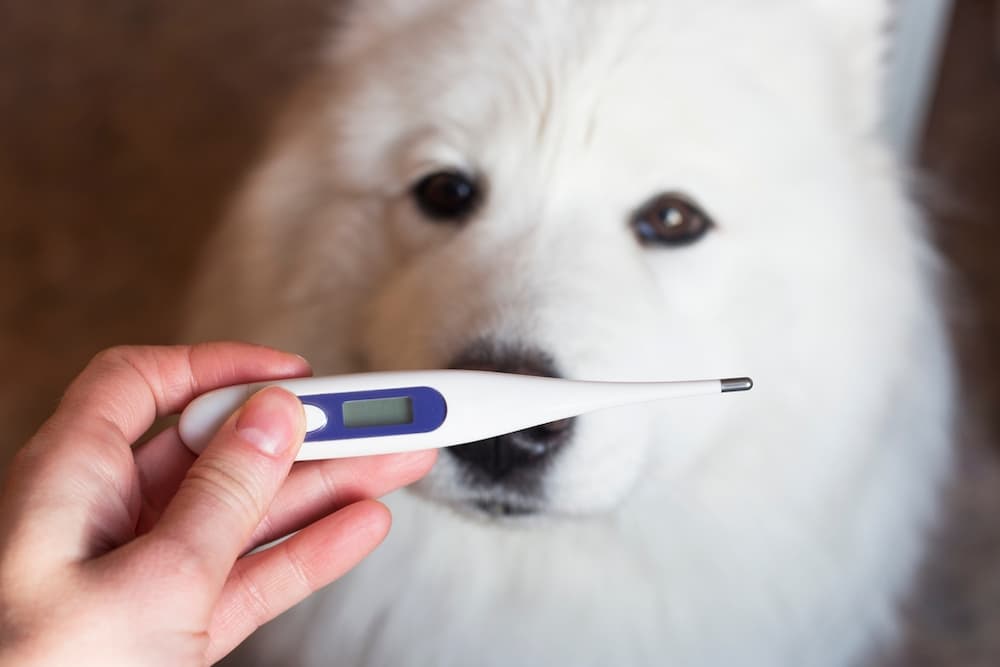
Dog thermometers are handy when your pooch seems ill, and you need to check their temperature. With some dogs, you can tell they’re sick just by looking at them, while other dogs may hide their discomfort when they’re feeling under the weather. That can leave some pet parents worried and unsure about monitoring their pet’s health.
Of course, you should always speak with your veterinarian if you suspect your pet is sick. But one good way to get insight into your dog’s health is by checking their temperature with one of our pet thermometer selections.
While that number won’t give you all the answers, it’s an important clue. And by using the right pet thermometer and following a few important tips, it can be easy, too. So here’s a helpful guide to monitoring your dog’s temperature, with some advice from a veterinary expert and our top picks for at-home dog thermometers.
Our List: Top Dog Thermometers
All featured products are chosen at the discretion of the Vetstreet editorial team and do not reflect a direct endorsement by the author. However, Vetstreet may make a small affiliate commission if you click through and make a purchase.
- Best Overall Thermometer for Dogs: iProven Waterproof Dog and Cat Thermometer
- Best Rectal Thermometer for Dogs: Well & Good Digital Pet Thermometer
- Best Non-Invasive Thermometer for Dogs: PetMedics Non-Contact Digital Thermometer for Dogs
- Best Underarm Pet Thermometer: Mella Pet Care
- Best Value Dog Thermometer: Sejoy 3-in-1 Thermometer for Adults, Kids, Baby & Pets
- Best Easy-to-Use Thermometer for Dogs: AURYNNS Pet Thermometer
6 Best Dog Thermometers
After considering the factors that make for the best dog thermometer and what would make them easy for pet parents to use, we found the following dog thermometers to recommend.
Best Overall Thermometer for Dogs
Our Pick: iProven Waterproof Dog and Cat Thermometer

The best overall thermometer for dogs is a basic, quick-read thermometer that is easy to use. In fact, this dog thermometer from iProven is easys to clean and waterproof with a flexible tip for your pet’s comfort. It takes your pet’s temperature rectally, which is the most accurate way to tell if your pet has a fever. Be sure to use it with a lubricant and a protective sheath every time. Because it is waterproof, clean up is easy.
Highlights
- Reads temperature quickly, in just 20 seconds
- Can be used rectally, considered to be the most accurate method for taking your dog’s temperature
- Comes with a storage case
- Empty battery alert and auto off feature
- Available at an affordable price
Things to Consider
- It must be used with a lubricant and protective sheath when taking your pet’s temperature rectally
- Often requires two people to safely take a rectal temperature: one person to gently restrain the dog, and one person to use the thermometer
- Hand wash only
Best Rectal Thermometer for Dogs
Our pick: Well & Good Digital Pet Thermometer
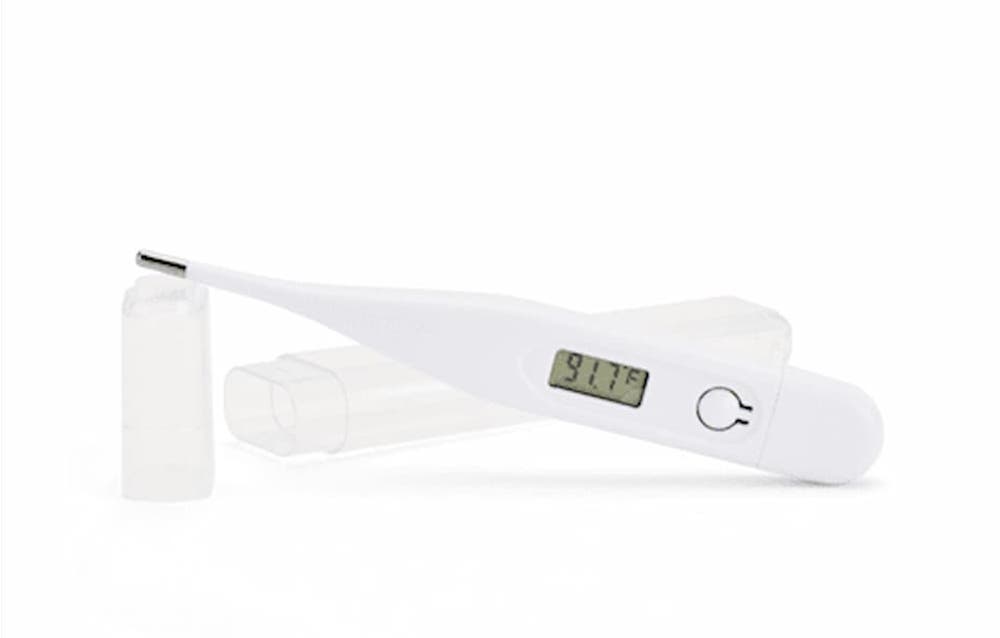
A rectal thermometer can give you the most accurate results, but it’s not always the easiest to use. In those cases, speed is a necessity. This thermometer provides a temperature in 10 seconds, with an easy-to-read digital screen. Like other rectal thermometers, it should be used with lubricant and a protective sheath. A digital dog thermometer is ideal for pet parents who feel secure in using one.
Highlights
- Results in just 10 seconds
- Automatic shut-off to preserve battery life
- This dog digital thermometer measures your pet’s temperature rectally
Things to Consider
- Be cautious and use lubricant and a protective sheath
- Results are only available in Fahrenheit
- Often requires two people to safely take a rectal temperature
Best Non-Rectal Thermometer for Dogs
Our Pick: PetMedics Non-Contact Digital Thermometer for Dogs
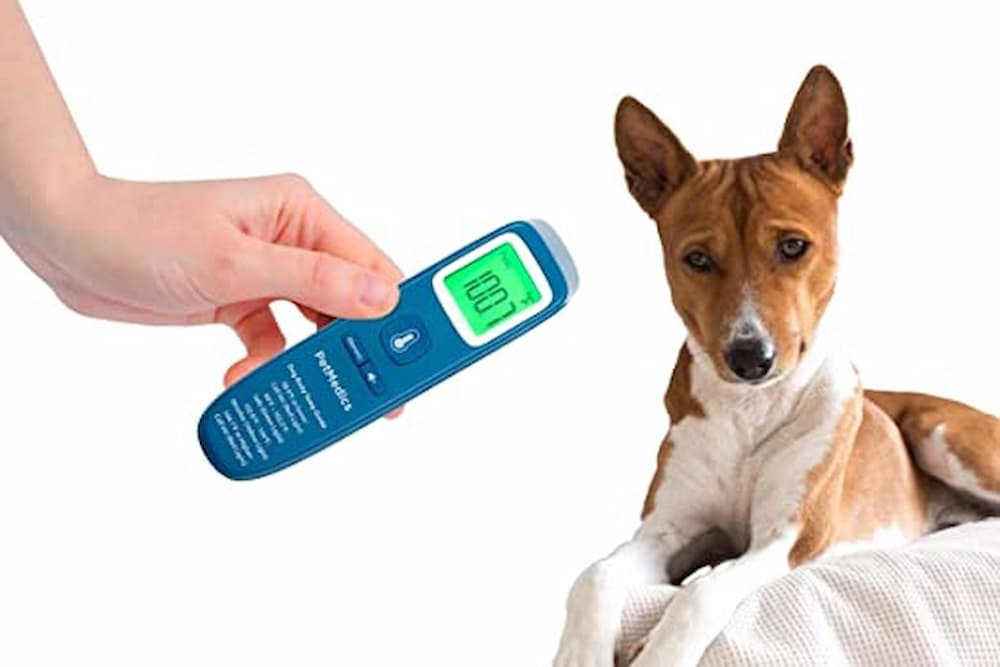
Despite being the most sure way to obtain an accurate temperature reading, using a rectal thermometer can be intimidating for both you and your pet. If you’re unable to use one, this no-contact digital thermometer for dogs might be the least stressful way to take your pet’s temperature. By simply pointing the thermometer at your pet’s belly or inner ear, you’ll get a readout in seconds. It also includes a memory so you can review past readings quickly, and a colored screen that correlates with your dog’s temperature.
Highlights
- The colored screen makes it easy to know when your pet has an abnormally high body temperature and when it’s time to bring your dog to the vet
- It gives a super fast readout so you can take your pet’s temperature quickly
- Silent mode for dogs who may be sensitive to beeps
- Includes memory recall so you can look back at previous readings
- Lights up in three colors to assess normal versus abnormal
Things to Consider
- Not as accurate as rectal thermometer
- More expensive than other options
Best Underarm Pet Thermometer
Our Pick: Mella Pet Care

As seen on the popular television show, Shark Tank, Mella Pet Care’s non-invasive underarm pet thermometer, makes the entire process smoother and less stressful. Used in conjunction with the Mella mobile app, you can track your dog’s temperature and send results to your veterinarian in real time. Designed for all ages from newborn to seniors, you’ll receive a reading within 10 to 15 seconds.
Highlights
- Enables a fear-free experience for you and your dog
- Temperature results are paired with the free Mella mobile app for tracking purposes
- Easily share results with your veterinarian through the app
- Charges with a provided USB-C cable
Things to Consider
- One of the more costly items on our list
- Some pet parents indicate a pet rectal thermometer was more accurate
Best Value Dog Thermometer
Our Pick: Sejoy 3-in-1 Thermometer for Adults, Kids, Baby & Pets
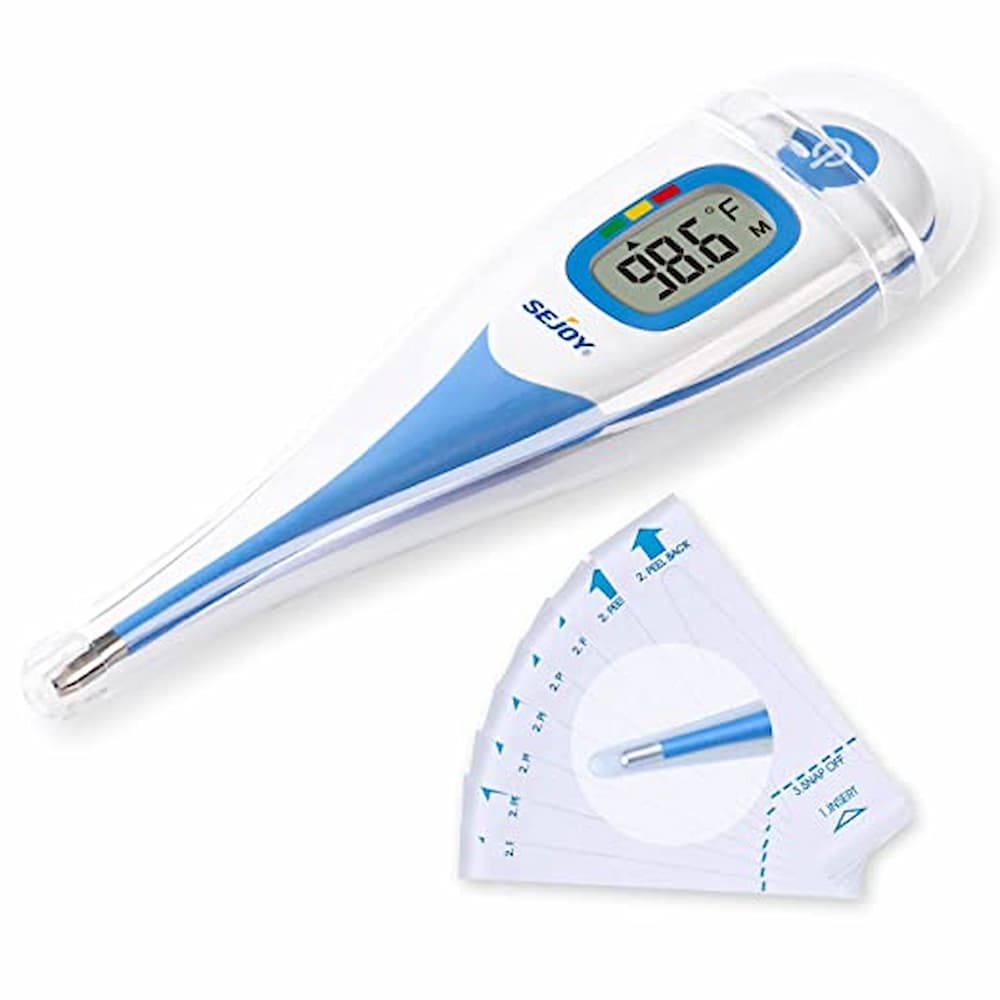
This thermometer is actually designed for adults, kids, and babies, but it has all the makings of a perfect dog thermometer as well. It gives a digital readout in just 5 to 10 seconds, making it one of the fastest thermometers available. It also has a flexible tip, which makes it safer to use when measuring your dog’s temperature rectally. Plus, this thermometer is one of the more affordable options—a steal considering all the included benefits. Keep in mind that while it’s a 3-in-1 thermometer for humans, in dogs this can only be used rectally.
Highlights
- Gives results in around 10 seconds
- Flexible tip for safety
- Affordable at under $15
- Comes with its own storage case
- Arrives with 10 probe covers
Things to Consider
- Be sure to designate the thermometer as ‘For Pets Only’
- No silent mode, so sensitive pups may be startled by beeping, but customers report that the beep is actually pretty soft
- Often requires two people to safely take a rectal temperature
Best Easy-to-Use Thermometer for Dogs
Our pick: AURYNNS Pet Thermometer
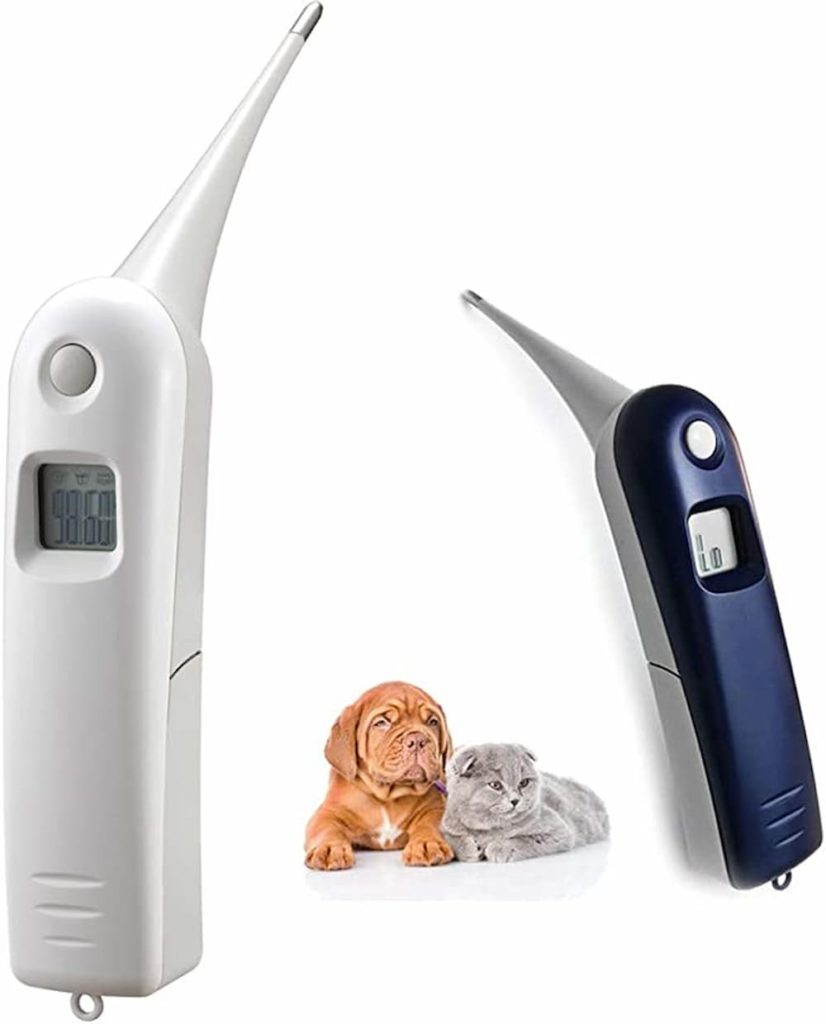
The AURYNNS pet thermometer is designed for rectal temperature taking, and the shape of the device can make it easier to hold and to obtain a temperature reading than traditional designs. It also takes a quick reading—nearly instantaneous—however some reviewers have stated that it took longer than advertised to complete temperature taking. It also has automatic shut off, displays in both Fahrenheit and Celsius, and stores temperature readings.
Highlights
- Design makes it easier to hold and read temperature
- Quick reading so there’s less stress for you and your pet
- LCD displays both Fahrenheit and Celsius
- Comes with two AAA batteries
- Alarm sounds if temperature is high
- Automatic shut off
Things to Consider
- May take longer to read temperature than it claims (20 to 30 seconds)
- Use appropriate methods when taking rectal temperature
- No silent mode available
- Often requires two people to safely take a rectal temperature
Can Dogs Get Fevers?

Just like any member of your human family, a sick dog may run a fever when they are ill. But a dog fever isn’t exactly the same as a human fever. A dog’s healthy temperature runs hotter than humans—typically around 99-101 degrees Fahrenheit, but can go as high as 102 in excited dogs. The fact that a dog’s normal body temperature is higher than a human’s means dog fevers are higher than human fevers, too.
If your dog’s temperature rises above 103 degrees F, this is a sign your pet either has a fever, hyperthermia or heat stroke. When their temperature rises above 106 degrees F, this indicates a severe and potentially high body temperature.
Dog Temperature Chart
In general, the following temperatures indicate normal, high, and severe temperatures in dogs.
| Normal | 99°F-102°F (37.2°C-38.9°C) |
| High | >102.5°F (39.2°C) |
| Severe | 104°F (40°C) and above |
In dogs, fevers can be caused by many of the same conditions that cause fevers in humans, including ear, tooth, or urinary tract infections, viral infections, or the ingestion of a poisonous substance. You can see what having a therometer for a dog in your life is worth having on hand.
How to Tell if a Dog Has a Fever

You might have heard that if a dog’s nose is warm and dry, they have a fever, or that red eyes signal illness, however, the most reliable way to tell if your pet has a fever is to take their temperature using a thermometer.
Keep in mind that the number on the thermometer only tells part of the story, says Dr. Marcus Dela Cruz, DVM, who is known as The Friendly Vet.
“Body temperature is a measurement of the body’s basic function and is considered a ‘vital sign,’ but it is not as straightforward as people may think,” Dela Cruz explains.
A sick pet can still have a normal temperature, and a healthy pet may have an abnormal one, says Dela Cruz. But it’s important to remember that while taking your dog’s temperature is a great way to get some concrete information (rather than relying on whether your dog “looks” or “acts” sick), it’s not definitive.
“My general rule of thumb is if a pet parent is concerned enough about their pet’s health to take their temperature, then it’s best to take the pet to the veterinarian,” advises Dela Cruz.
Dog Fever Symptoms
So when should you take your dog’s temperature? Signs that might indicate your dog is sick with a fever include:
- Lethargy or general lack of energy
- Loss of appetite
- Vomiting and/or diarrhea
- Ears feel warmer to the touch than normal
- Shivering
Remember that these are not the only signs of a fever-related sickness, and your dog can still have a fever without exhibiting these symptoms.
How to Take a Dog’s Temperature

You can use a few different methods to take your dog’s temperature, each with varying degrees of difficulty and accuracy. Here’s how to check a dog’s temp:
Rectal Dog Temperature: Dela Cruz recommends taking your pet’s temperature rectally because this method provides the most accurate reading. To do this, gently insert the tip of a dog rectal thermometer gently into your pet’s rectum—about 1 inch for small dogs and 2 inches for larger dogs. To ease any discomfort your dog may feel, you should use a pet-safe lubricant on the tip of the thermometer.
A rectal thermometer for dogs can be tricky if you are unsure of proper technique or if your dog resists. Your veterinarian can show you step-by-step how to use a rectal thermometer in the office. You never want to place the thermometer into stool contained in the rectum, as this can give an inaccurate reading.
Dog Ear Temperature: You can also take your dog’s temperature via their ear. However you’ll need a specialized dog ear thermometer, and the reading is not as accurate as rectal temperature. Place the dog thermometer into your pet’s ear at a horizontal, 90-degree angle to their head. If your pet has an ear infection, you may want to try other methods to take their temperature, as using a thermometer on the infected ear may be painful.
A dog ear thermometer measures the infrared heat waves around the eardrum. This is more comfortable if performed properly, but your technique is essential. What makes an ear thermometer for dogs even better is the speed of the readings, which generally takes a few seconds. Consider talking to your veterinarian to have them show you the right method.
Infrared Dog Temperature: And finally, the least invasive method is infrared thermometers. These read temperatures from the skin, either from the inner ear or your pet’s armpits. While not as accurate as a rectal thermometer for dogs, they can give you a general idea of your pet’s temperature.
With all methods, be careful not to force the thermometers onto your pet. If it becomes difficult to measure their temperature or causes unnecessary stress to you or your dog, speak with your veterinarian before proceeding.
Dog Thermometers Buyer’s Guide

When shopping for a thermometer, consider how you will take your dog’s temperature. If you are comfortable using a rectal thermometer, choose one with that purpose in mind. “Because temperature is taken rectally in pets, I generally like thermometers that are tapered and less rigid. It also helps when the thermometer gives a quick reading,” says Dela Cruz.
If you’ll be taking your dog’s temperature through other methods, choose a good quality thermometer that allows for a more accurate reading. Some thermometers have a “silent” mode that keeps them from beeping, which is a good feature to look for if you have an easily startled dog.
For less invasive temperature taking, an infrared canine thermometer (like forehead readers you may already have at home) can be used, but the results may not be as accurate. Remember that these must be used on the skin of the inner ear or your dog’s armpit.
Thermometers for Dogs FAQ

How to tell if a dog has a fever without a thermometer?
While signs often accompany a fever, the only way to know for sure whether your pet has a fever is by taking their temperature. Signs that your pet may have a temperature include losing energy, shivering, and not eating. Pets that have fevers often have ears that feel warmer than usual. Remember that your pet may have an elevated body temperature even without showing any signs.
Never second guess whether your dog has a fever or not. The right pet thermometer used the proper way is the best way to discern if your dog’s temperate is elevated.
Can you use a human thermometer on a dog?
Yes, you can use a human thermometer on a dog. Be sure to clearly designate that thermometer as ‘For Pet Use’ only to avoid using your dog’s thermometer with you or your family. However, you should avoid using glass thermometers because they can be dangerous if they break.
Can you take a dog’s temp with a forehead thermometer?
While you can’t take your dog’s temperature from their forehead, you may be able to use a forehead thermometer on your pet. Forehead thermometers often take temperature via infrared, which can be used on the skin of your dog’s inner ear and armpits. Remember that taking your dog’s temperature rectally is still the most accurate way to measure their temp, but this method may still provide a general idea of your pet’s temperature. This type of thermometer is most accurate when used on hairless areas of your pet, such as the belly, armpit, or ear.
Because a dog’s head is covered in fur, whether thick or sparse, you will not get an accurate reading on the forehead using a forehead thermometer.
Is there a special puppy thermometer I should use?
Although puppies do not require a specific puppy thermometer, pet parents should take extra precautions on a pup’s delicate rectal area. Most veterinarians use a dog rectal thermometer on puppies during checkups and examinations. Like adult dogs, the tip is lubricated and inserted gently about one inch into the rectum.
Of note, puppies tend to have a slightly higher baseline (normal) temperature compared to adult dogs. The normal range for puppies is 101.5 to 102.5 degrees Fahrenheit (38.6 to 39.2 degrees Celsius).
Dog Thermometer: Tips for Success
- Don’t be afraid to ask for help when taking your dog’s temperature. “Taking a temperature at home is generally a two-person job but can be accomplished by one if the person is particularly skilled at handling dogs or if the dog is very compliant,” says Dela Cruz.
- When taking a rectal temperature, a lubricant should be used every single time. And while it’s the most accurate way to tell your dog’s temperature, if any fecal matter is in the rectum, the temperature may read falsely low.
- Don’t force your dog to have their temperature taken. “If you can’t take temperature in a gentle fashion, then the information you would gain is not worth the traumatic experience for the pet,” says Dela Cruz.
- Most importantly, if you notice your pet is behaving differently and suspect a fever or illness, the best thing you can do for your dog is to bring them to the vet.






